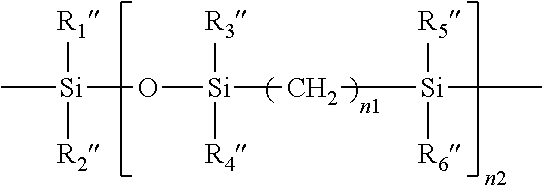Method for producing contact lenses with durable lubricious coatings thereon
a technology of lubricious coating and contact lens, which is applied in the direction of instruments, other domestic objects, optical elements, etc., can solve the problems of low production efficiency, poor surface lubricity of silicone hydrogel contact lens, and poor durability of lbl coating
- Summary
- Abstract
- Description
- Claims
- Application Information
AI Technical Summary
Benefits of technology
Problems solved by technology
Method used
Image
Examples
example 1
Oxygen Permeability Measurements
[0245]The apparent oxygen permeability (Dkapp), the apparent oxygen transmissibility (Dk / t), the intrinsic (or edge-corrected) oxygen permeability (Dkc) of a lens and a lens material are determined according to procedures described in Example 1 of U.S. patent application publication No. 2012 / 0026457 A1 (herein incorporated by reference in its entirety).
Digital Rubbing Tests.
[0246]The lenses are digitally rubbed (wearing disposable powder-free latex gloves) with RENU® multi-purpose lens care solution (or another multi-purpose lens care solution) for 20 seconds and then rinsed with saline. The above procedure is repeated for a given times, e.g., from 1 to 30 times, (i.e., number of repetitions of digital rubbing tests which imitate cleaning and soaking cycles).
Lubricity Evaluation.
[0247]The lubricity of a lens is evaluated by using a finger-felt lubricity test which characterizes qualitatively the slipperiness of a lens surface on a friction rating scal...
example 2
Synthesis of Macromers
[0257]Macromers are synthesized according to the procedures similar to those described in Example B-1 to B-4 of U.S. Pat. No. 5,849,811.
[0258]51.5 g (50 mmol) of the perfluoropolyether Fomblin® ZDOL (from Ausimont S.p.A, Milan) having a mean molecular weight of 1030 g / mol and containing 1.96 meq / g of hydroxyl groups according to end-group titration is introduced into a three-neck flask together with 50 mg of dibutyltin dilaurate. The flask contents are evacuated to about 20 mbar with stirring and subsequently decompressed with argon. This operation is repeated twice. 22.2 g (0.1 mol) of freshly distilled isophorone diisocyanate kept under argon are subsequently added in a counterstream of argon. The temperature in the flask is kept below 30° C. by cooling with a waterbath. After stirring overnight at room temperature, the reaction is complete. Isocyanate titration gives an NCO content of 1.40 meq / g (theory: 1.35 meq / g).
[0259]202 g of the α,ω-hydroxypropyl-termi...
example 3
1 mM PAA (pH=2) Solution
[0263]To prepare 1 mM Poly(Acrylic Acid) (PAA) aqueous solution, 0.072 g PAA (Carbopol 907, powder) is gradually transferred into the 1000 ml bottle containing distilled water under stirring. Ensure the solution is stirring during the PAA addition. Stir the solution on the stirrer plate at room temperature overnight (˜24 hrs). Verify that the PAA has fully dissolved. If the PAA has NOT fully dissolved, continue stirring and wait until no particulates are observed. 37% Hydrochloric add solution (HCl, Fluka-318949) is applied to adjust pH of the 1 mM PAA solution to 2 under the pH meter.
PBS (Phosphate-Buffered Saline).
[0264]To prepare PBS saline, 8 g of NaCl; 0.2 g of KCl; 1.44 g of Na2HPO4; 0.24 g of KH2PO4 are dissolved in 800 ml distilled H2O. After adjusting pH to 7.4 with HCl, additional distilled H2O is then added to meet 1 L volume.
IPC-1 Saline.
[0265]Poly(AAm-co-AA)(90 / 10) partial sodium salt (˜90% solid content, poly(AAm-co-AA) 90 / 10, Mw 200,000) is pur...
PUM
| Property | Measurement | Unit |
|---|---|---|
| thickness | aaaaa | aaaaa |
| temperature | aaaaa | aaaaa |
| weight average molecular weight | aaaaa | aaaaa |
Abstract
Description
Claims
Application Information
 Login to View More
Login to View More - R&D
- Intellectual Property
- Life Sciences
- Materials
- Tech Scout
- Unparalleled Data Quality
- Higher Quality Content
- 60% Fewer Hallucinations
Browse by: Latest US Patents, China's latest patents, Technical Efficacy Thesaurus, Application Domain, Technology Topic, Popular Technical Reports.
© 2025 PatSnap. All rights reserved.Legal|Privacy policy|Modern Slavery Act Transparency Statement|Sitemap|About US| Contact US: help@patsnap.com



